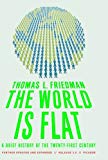
The World Is Flat is a book by Thomas Friedman discussing the trends of globalization in the 21st century. Friedman describes himself as a "free-trader," arguing in favor of the rapid shifts towards a more interconnected economic world after the fall of the USSR as a result of the Internet, computers, outsourcing and workflow software. Friedman also presents his controversial Dell Theory of Conflict Prevention: that corporations' increased dependency on foreign labor and resources will prevent armed conflict.
Acknowledging that the ten factors he discussed in Chapter Two could not have flattened the world all on their own, Friedman explains that as each of the factors came together, they had to spread and take root to create the environment rich for flattening. He credits this spread, the creation of complementary software and the internet, and political factors that caused several developing countries, including China, Russia, India and Latin America, to open their borders at this time with the creation of the perfect storm that led to the rapid-fire pace of globalization.
Through interviews with U.S. Embassy officials in Beijing, we explore the desperation of Chinese students to study and work in America. For the first time in history, we see that talent has become more important than geography in determining a person’s opportunity in life. We follow the path of a Boeing jet as components of its manufacture are outsourced to Russia and then India, allowing for faster and cheaper development of more planes as Friedman demonstrates the need for individuals and businesses to be able to compete in a global marketplace.
Friedman works to dispel common myths about globalization as we explore the dot.com boom and bust, the American government’s misinformation of the public as the triple convergence took place and the IT revolution we have heard so much about in the last 20 years.
Already have an account? Log In Now